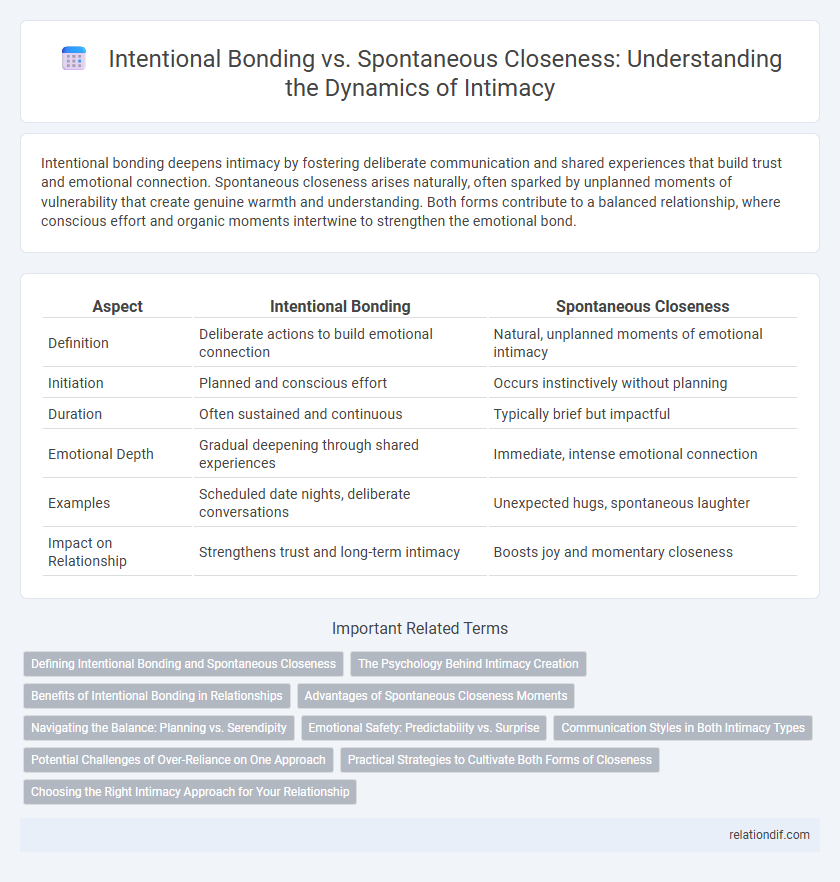Intentional bonding deepens intimacy by fostering deliberate communication and shared experiences that build trust and emotional connection. Spontaneous closeness arises naturally, often sparked by unplanned moments of vulnerability that create genuine warmth and understanding. Both forms contribute to a balanced relationship, where conscious effort and organic moments intertwine to strengthen the emotional bond.
Table of Comparison
| Aspect | Intentional Bonding | Spontaneous Closeness |
|---|---|---|
| Definition | Deliberate actions to build emotional connection | Natural, unplanned moments of emotional intimacy |
| Initiation | Planned and conscious effort | Occurs instinctively without planning |
| Duration | Often sustained and continuous | Typically brief but impactful |
| Emotional Depth | Gradual deepening through shared experiences | Immediate, intense emotional connection |
| Examples | Scheduled date nights, deliberate conversations | Unexpected hugs, spontaneous laughter |
| Impact on Relationship | Strengthens trust and long-term intimacy | Boosts joy and momentary closeness |
Defining Intentional Bonding and Spontaneous Closeness
Intentional bonding involves deliberate actions and conscious efforts to build trust, communicate openly, and create emotional safety in relationships. Spontaneous closeness arises naturally through unplanned moments of shared joy, vulnerability, or physical affection without premeditation. Both forms contribute to intimacy, but intentional bonding establishes a stable foundation, while spontaneous closeness strengthens emotional connection through authenticity.
The Psychology Behind Intimacy Creation
Intentional bonding involves consciously investing time and effort to build trust and emotional connection, which activates neural pathways linked to attachment and oxytocin release. Spontaneous closeness arises naturally through unplanned interactions that trigger mirror neurons and foster empathy, enabling instant emotional resonance. Psychological studies reveal that both processes engage distinct but complementary brain regions essential for deep intimacy formation and relationship satisfaction.
Benefits of Intentional Bonding in Relationships
Intentional bonding in relationships fosters deeper trust, enhanced communication, and emotional security by prioritizing consistent nurturing of connection. This deliberate approach to intimacy strengthens resilience against conflicts and promotes mutual understanding through shared experiences and purposeful quality time. Couples who engage in intentional bonding report higher satisfaction and long-term stability compared to those relying solely on spontaneous closeness.
Advantages of Spontaneous Closeness Moments
Spontaneous closeness moments foster authentic emotional connections by encouraging genuine reactions and reducing pressure to perform or meet expectations. These unplanned interactions often lead to heightened feelings of trust and vulnerability, strengthening relationship bonds organically. Experiencing spontaneous intimacy promotes a sense of presence and mindfulness, enriching the overall relational dynamic with depth and warmth.
Navigating the Balance: Planning vs. Serendipity
Intentional bonding involves deliberate actions and planned moments to deepen intimacy, fostering secure attachment and trust through consistent effort. Spontaneous closeness emerges from unplanned, authentic interactions that create natural emotional connections and promote vulnerability. Navigating the balance between planning and serendipity in relationships enhances relational satisfaction by integrating meaningful rituals with open, flexible experiences.
Emotional Safety: Predictability vs. Surprise
Intentional bonding fosters emotional safety through predictability, creating a reliable foundation where partners feel secure and understood, reducing anxiety and building trust over time. Spontaneous closeness introduces surprise and excitement, which can enhance connection but may also challenge emotional stability if unpredictability triggers uncertainty. Balancing predictable support with occasional spontaneous moments ensures a dynamic intimacy that nurtures emotional safety while keeping the relationship engaging.
Communication Styles in Both Intimacy Types
Intentional bonding relies on clear, purposeful communication where partners express needs and boundaries to deepen emotional connection. Spontaneous closeness often involves nonverbal cues and natural, unplanned interactions that create immediate feelings of warmth and trust. Effective communication in both intimacy types enhances understanding, fostering stronger relational bonds and emotional safety.
Potential Challenges of Over-Reliance on One Approach
Over-reliance on intentional bonding can lead to forced interactions that may feel unnatural, potentially stifling genuine emotional expression. Conversely, depending solely on spontaneous closeness risks missed opportunities for deep connection due to lack of deliberate effort or communication. Balancing both approaches is essential to foster resilient intimacy and avoid relational stagnation or emotional disconnect.
Practical Strategies to Cultivate Both Forms of Closeness
Intentional bonding thrives on deliberate actions such as scheduled conversations, shared rituals, and expressing appreciation, which strengthen emotional connection through consistency and presence. Spontaneous closeness emerges from unplanned moments of vulnerability, playful interactions, and genuine curiosity that foster natural intimacy and emotional warmth. Balancing practical strategies like setting aside quality time and staying open to in-the-moment experiences cultivates both structured and organic forms of closeness in relationships.
Choosing the Right Intimacy Approach for Your Relationship
Intentional bonding involves consciously creating moments of connection through planned activities and open communication, fostering deeper trust and understanding over time. Spontaneous closeness arises naturally from shared experiences and emotional chemistry, often sparking immediate but sometimes fleeting intimacy. Evaluating your relationship's needs and personalities helps determine whether deliberate efforts or organic interactions best cultivate lasting emotional intimacy.
Intentional bonding vs spontaneous closeness Infographic

 relationdif.com
relationdif.com